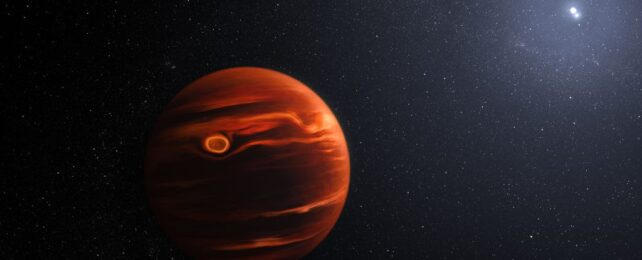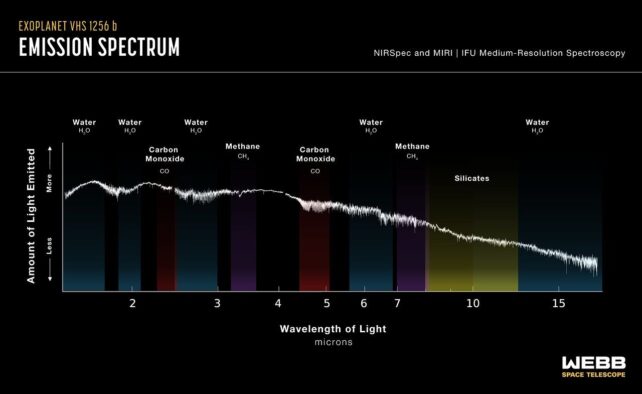 Artist's impression of VVHS 1256 b, with its swirling cloudy atmosphere and two suns. (NASA, ESA, CSA, J. Olmsted/STScI)
Artist's impression of VVHS 1256 b, with its swirling cloudy atmosphere and two suns. (NASA, ESA, CSA, J. Olmsted/STScI)
An alien world just 70 light-years from Earth is one of the strangest we have found yet.
It clocks in at 20 Jupiter masses, has temperatures that could quickly melt aluminum, and has a 10,000-year orbit around not one but two stars. And, oh yeah: It's ravaged by a constant, tempestuous storm of sand.
Astronomers have used the James Webb Space Telescope to obtain the most high-fidelity observations yet of the planetary-mass object, revealing roiling clouds of silicate grains circulating in the atmosphere of the world named VHS 1256 b.
The discovery, published last year on the preprint server arXiv, has gone through the peer review process and is due to appear in The Astrophysical Journal Letters.
In addition, the team identified many of the components of VHS 1256 b's atmosphere. Those include unambiguous detections of methane, carbon monoxide, and water, with additional evidence of carbon dioxide.
"No other telescope has identified so many features at once for a single target," says astrophysicist Paul Mollière of the Max Planck Institute for Astronomy in Germany. "We're seeing many molecules in a single spectrum from the JWST that detail the planet's dynamic cloud and weather systems."
VHS 1256 b is somewhat of an enigma. Its mass straddles the boundary between giant planets and brown dwarfs, "failed stars" that aren't massive enough to fuse hydrogen but that can fuse the heavier hydrogen isotope deuterium in their cores, which has lower fusion temperature and pressure than hydrogen.
It's thought that the two types of objects form pretty differently. Brown dwarfs generally form like stars, collapsing from a dense knot of material in a cloud of gas and dust and then sucking in more material to grow. Deuterium fusion is an intermediary step as the star grows, but some stars – the brown dwarfs – stop growing at that point and stay as they are.
On the other hand, planets are thought to form from the bottom up, from the material left over after a star has formed, clumping together to grow into a planet. That material is thought to be usually pretty close to the star. The wide orbital separation of VHS 1256 b from its two suns suggests that it formed by cloud collapse, but that's not diagnostic.
Theoretically, planets can also form from the cloud collapse model; the estimated minimum mass for a cloud collapse object is one Jupiter. The dividing line between a planet and a brown dwarf is, therefore, the deuterium-burning mass limit, which means that VHS 1256 b's precise nature is unknown.
But it's that great distance that allowed such spectacular observations.
"VHS 1256 b is about four times farther from its stars than Pluto is from our Sun, which makes it a great target for Webb," says astronomer Brittany Miles of the University of Arizona, who led the international research team. "That means the planet's light is not mixed with light from its stars."
JWST's observation range is the infrared and near-infrared, the range that includes thermal radiation. And VHS 1256 b is very young, at just 150 million years old, and still quite hot from the process of forming. Its atmosphere, where the sand clouds can be found, reaches 830 degrees Celsius (1,526 degrees Fahrenheit).

This heat, along with its low gravity, is what makes its skies so turbulent. Scientists analyzed the light detected by JWST, studying the spectrum in minute detail to pick out the features produced by various elements absorbing specific wavelengths.
This is how they identified the various gases they found in the object's atmosphere – and the clouds of sand that are constantly changing, likely composed of enstatite, forsterite, or quartz.
So detailed was the data that researchers were able to identify different sizes of grains, too, from finer grains like particles of smoke to larger grains like sand. These larger grains, the researchers hypothesized, are too heavy to remain in the upper atmosphere and rain back down into the interior, as smaller particles rise.
This produces a dramatic variation in the world's brightness over its 22-hour day, suggesting that silicate clouds might be a common mechanism for making such variations in brown dwarfs. The team believes the observations could be easily replicated for other brown dwarfs, which could help us learn more about these strange objects.
And VHS 1256 b has given us a lot to chew on.
"We've isolated silicates, but better understanding which grain sizes and shapes match specific types of clouds is going to take a lot of additional work," says astrophysicist Elisabeth Matthews of the Max Planck Institute for Astronomy.
"This is not the final word on this planet – it is only the beginning of a large-scale modeling effort to understand JWST's complex data."
The research has been published in The Astrophysical Journal Letters.






0 Comments